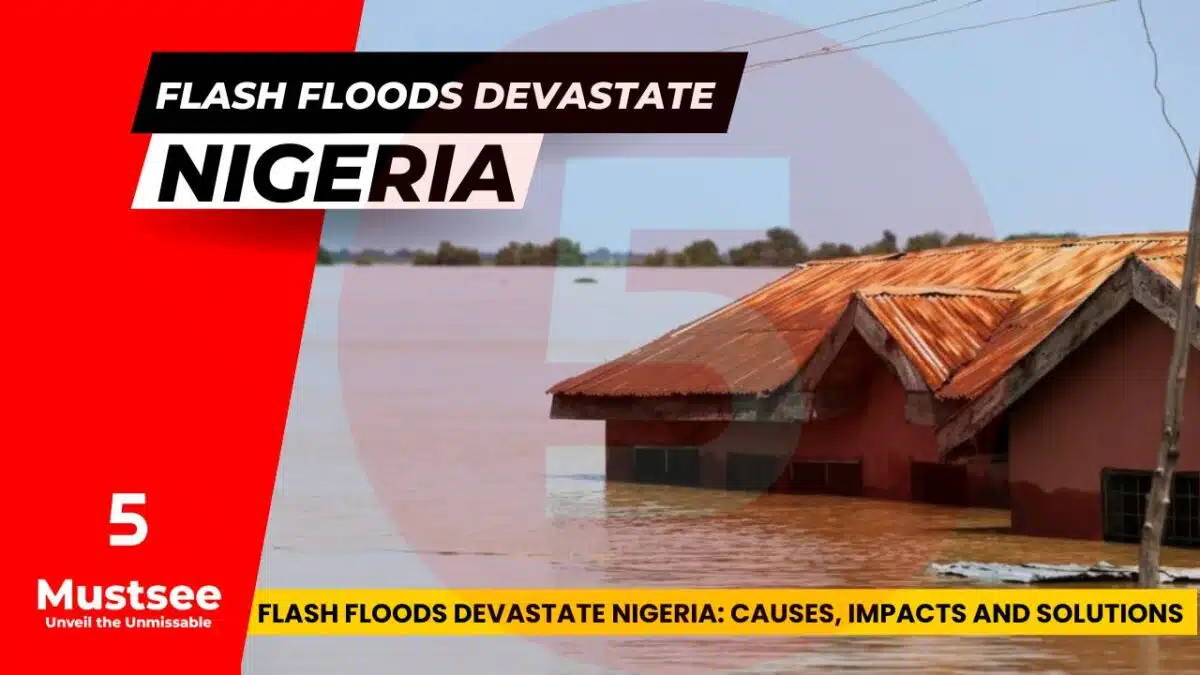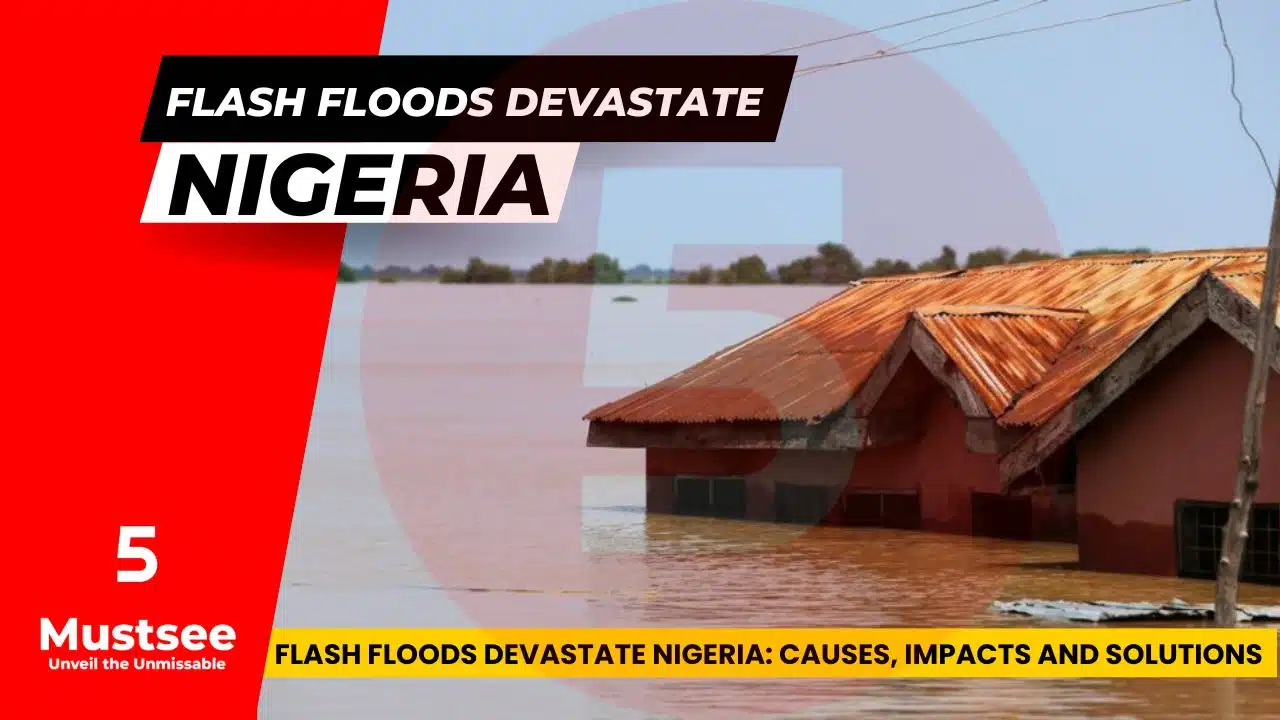Flush floods stand out as one of the most devastating Natural disasters that can impact any nation. It happens with rapid water flow, often from heavy rain, melting snow, or dam failure, over a short time. It can severely damage life, property, and the environment, especially in areas lacking preparation or adequate infrastructure.

Flash floods have severely affected Nigeria in recent years. Nigeria is a West African nation with a population of about 214 million people. It has a diverse geography ranging from coastal plains to mountains, plateaus, and savannas. Its tropical climate also varies from humid in the south to arid in the north. Nigeria possesses abundant resources like oil, gas, minerals, and agriculture but struggles with poverty, corruption, insecurity, and environmental degradation.
This article will delve into 2023’s devastating flash floods in Nigeria. Explore causes, impacts, solutions, and ways to contribute. Are you interested in global news? Discover details about Nigeria, Federal Capital Territory, Flood, Kwara, Edo, and Flash flood here.
Three factors mainly caused the flash floods that occurred in Nigeria in 2023:
- heavy and prolonged rainfall
- poor urban planning and infrastructure
- emergency release of excess water from dams
Heavy and Prolonged Rainfall
Heavy, prolonged rainfall in March and April 2023 primarily caused the flash floods, affecting various parts of Nigeria. According to the Nigerian Meteorological Agency (NiMet), climate change and seasonal variations contributed to above-average rainfall. The La Niña phenomenon, a Pacific Ocean cooling, influenced global weather patterns, impacting Nigeria’s rainfall.
The heavy rainfall resulted in overflowing rivers, streams, and lakes that flooded many low-lying areas. Kwara, Edo, Kogi, and other states faced severe floods. The Federal Capital Territory, including Abuja, was also inundated by the Gurara River.
Poor Urban Planning and Infrastructure
Another contributing factor to the flash floods was poor urban planning and infrastructure. Poor Urban Planning and Infrastructure led to increased runoff and reduced drainage. Nigeria’s cities faced rapid urban growth without essential infrastructure like roads, bridges, sewers, and storm drains, hampering development. And it has led to congestion, pollution, and encroachment on natural waterways.
More drainage led to rainwater accumulation on streets and buildings, with no outlet for excess rainfall. The poor quality of roads and bridges also made them vulnerable to collapse or damage by the floodwaters. Solid waste and debris on streets and waterways also blocked water flow, worsening the flooding problem.
Emergency Release of Excess Water from Dams
Emergency release of surplus water from dams in Nigeria and Cameroon constituted a third factor causing the flash floods. Intense rainfall-filled barriers to capacity raise the risk of failure or breach due to excessive water levels. The authorities had to release water from the dams to prevent the pressure from building up too much. However, this also increased the volume and speed of water downstream, causing more flooding in some areas. Involved dams included Lagdo Dam in Cameroon, Nigeria, Jebba Dam, Kainji Dam, and Shiroro Dam.
What Were the Impacts of the Flash Floods in Nigeria?
Flash floods severely affected various aspects of Nigeria, including human lives, livelihoods, health, and the environment.
Human Lives
Flash floods in Nigeria resulted in over 600 deaths, marking one of the country’s deadliest natural disasters in history. Many people drowned, were swept away, or were trapped in their homes or vehicles by the floodwaters. Some people also died from electrocution, landslides, or building collapse.
The flash floods also displaced about 1.3 million people from their homes and communities. Many people lost their belongings, documents, and valuables to the floods. Some people had to seek refuge in makeshift camps, schools, churches, or mosques. Others had to rely on the generosity of relatives, friends, or strangers for shelter and support.
The flash floods also destroyed about 200,000 homes and damaged nearly 500,000 more. Many homes were submerged, washed away, or collapsed by the floodwaters. Some houses were also looted or vandalized by criminals who took advantage of the chaos. The flash floods also injured about 500 people who suffered from cuts, bruises, fractures, or infections.
Livelihoods
The flash floods also affected the livelihoods of millions of Nigerians who depend on agriculture, trade, or industry for their income. The flash floods destroyed large swathes of farmland and crops, especially rice, maize, cassava, yam, and vegetables. The floods also caused the death or displacement of thousands of livestock, including cattle, sheep, goats, pigs, and poultry. The loss of agricultural production and income threatened the food security and nutrition of many people who faced hunger and malnutrition.
The flash floods also disrupted the supply and distribution of food and fuel in many areas. The floods damaged roads, bridges, railways, pipelines, and power lines essential for transportation and communication. Difficulties or impossibilities arose for farmers in selling their produce or accessing markets.
It also made it complicated or costly for consumers to buy food or fuel. The scarcity and inflation of food and fuel prices increased the hardship and suffering of many people.
The flash floods also affected Nigeria’s industrial sector, contributing about 25% of the country’s gross domestic product (GDP). The floods damaged factories, warehouses, machines, equipment, and raw materials vital for production and manufacturing. The floods also disrupted the operations and activities of many businesses and industries, such as oil and gas, mining, construction, banking, telecommunications, and tourism. The loss of industrial output and revenue reduced Nigeria’s economic growth and development.
Health
The flash floods also exposed millions of Nigerians to diseases and infections, posing severe health risks.
The flash floods contaminated many water sources, such as wells, boreholes, rivers, and lakes, with dirt, debris, chemicals, sewage, or corpses. As a result, the water became unsafe for drinking or washing, contributing to the increased spread of waterborne diseases such as malaria, cholera, typhoid, dysentery, and hepatitis A and E.
The flash floods also created favorable conditions for breeding mosquitoes and other vectors that transmit diseases such as yellow fever, dengue fever, and Zika virus—and also increased the risk of respiratory infections such as pneumonia, tuberculosis (TB), and asthma. The flash floods also exacerbated the COVID-19 pandemic that was already ravaging Nigeria. The floods made it harder for people to observe social distancing or hygiene measures. The floods also strained health facilities and workers already overwhelmed by the pandemic.
Environment
The flash floods also negatively impacted Nigeria’s environment, which supports life and biodiversity. The flash floods eroded the soil and washed away the topsoil rich in nutrients and organic matter. this reduced the fertility and productivity of the land for agriculture or forestry. The erosion also increased the sedimentation and turbidity of water bodies, affecting aquatic life.
The flash floods also caused biodiversity loss and habitats for many plants and animals that are endemic or endangered in Nigeria. The floods destroyed forests, wetlands, grasslands, and savannas, home to many species, such as elephants, lions, giraffes, antelopes, monkeys, birds, reptiles, amphibians, and fishes. The floods also threatened protected zones like national parks, game reserves, and wildlife sanctuaries, which play a crucial role in conserving biodiversity and ecosystem services.
The flash floods also polluted the environment with various substances harmful to humans and nature. The floods carried solid waste and debris, such as plastic bottles, cans, bags, and wrappers., that littered the streets and waterways. The floods also had
chemicals, sewage, or corpses that contaminated the water and soil with pathogens, toxins, or nutrients. Environment affects the health and quality of water and soil for humans and nature. Greenhouse gases like CO2, CH4, and N2O, which cause the planet to warm up and the climate to change, escaped into the air because of the floods.
How Can We Solve the Flash Flood Problem in Nigeria?
The flash flood problem in Nigeria is a serious and complex one that requires urgent and comprehensive action from various stakeholders. The Nigerian government and other stakeholders have taken or are planning some efforts to address the flash flood crisis.
Providing Relief and Support to the Affected People
One of the immediate actions taken is providing relief and support to people who lost their lives, homes, or livelihoods. The Nigerian government has declared a state of emergency in the affected states and allocated funds and resources for humanitarian assistance. The government has also deployed security forces, emergency workers, and volunteers to rescue, evacuate, and assist the affected people.
The government has also collaborated with international organizations such as the United Nations (UN), the World Health Organization (WHO), the World Food Programme (WFP), the International Committee of the Red Cross (ICRC), and other non-governmental organizations (NGOs) to provide food, water, shelter, medical care, and additional support to the affected people. Some organizations have also launched appeals and campaigns to raise funds and awareness for the flash flood crisis.
Relocating People from High-Risk Areas to Safer Places
People from high-risk zones were relocated to safer areas, allowing them to rebuild lives and livelihoods, constituting another action taken. The Nigerian government has identified some areas prone to flooding and advised or ordered people to vacate them. The government has also provided alternative sites or settlements where people can resettle or relocate.
However, this action has faced challenges or obstacles, such as lack of funds, resources, coordination, or political will. Some people have also resisted or refused to leave their homes or communities due to attachment, tradition, or livelihood. Some people have also returned to their flooded areas after the water receded due to a lack of options or opportunities.
Repairing and Improving the Damaged Infrastructure and Facilities
A third action that has been taken or planned is to repair and improve the damaged infrastructure and facilities that are essential for transportation, communication, production, and service delivery. The Nigerian government has assessed the extent and cost of the damage caused by the flash floods and allocated funds and resources for reconstruction and rehabilitation. The government has also contracted local or foreign companies or agencies to perform repair and improvement works.
However, this action has faced challenges or obstacles, such as lack of funds, resources, coordination, or political will. Some repair and improvement works have been delayed, abandoned, or substandard due to corruption, mismanagement, or inefficiency. Due to poor quality or design, some of the infrastructure and facilities have been damaged again by subsequent floods.
Implementing Disaster Risk Reduction and Management Strategies
A fourth action that has been taken or planned is implementing disaster risk reduction and management strategies that can prevent or mitigate future flash floods in Nigeria. The Nigerian government has adopted some policies
and plans that aim to reduce the exposure and vulnerability of people and assets to flash floods and enhance their resilience and recovery. Some of these policies and procedures include:
- It is developing and implementing a national flood management plan that covers all aspects of flood prevention, preparedness, response, and recovery.
- It establishes and strengthens a national hydrological and meteorological service that can provide accurate and timely information on rainfall, water levels, flood forecasts, and warnings.
- It is developing and enforcing land use planning and building codes that can regulate the development and construction of settlements, infrastructure, and facilities in flood-prone areas.
- It is constructing and maintaining flood control structures such as dams, dikes, levees, canals, culverts, and retention basins. That can regulate the flow of water and reduce the risk of flooding.
- It promotes and supports community-based flood management initiatives that can involve the participation and empowerment of local people in flood risk assessment, mitigation, adaptation, and coping.
However, this action has faced challenges or obstacles, such as lack of funds, resources, coordination, or political will. Some disaster risk reduction and management strategies must be more effective, adequate, or consistent due to corruption, mismanagement, or inefficiency. Some people or groups have opposed or resisted some approach due to lack of awareness, education, or incentives.
Conclusion
Flash floods are a serious and complex problem in Nigeria with multiple causes, impacts, and possible solutions. Heavy and prolonged rainfall, poor urban planning and infrastructure, and emergency release of excess water from dams primarily caused flash floods in Nigeria in 2023.
The flash floods devastated human lives, livelihoods, health, and the environment. They also required urgent and comprehensive action from various stakeholders to provide relief and support to the affected people, relocate people from high-risk areas to safer places, repair and improve the damaged infrastructure and facilities, and implement disaster risk reduction and management strategies.
The flash flood problem in Nigeria is not only a national issue but also a global one. Climate change, a global phenomenon, affects weather patterns and rainfall distribution, linking it to the flash floods in Nigeria. The flash floods in Nigeria also affect the international community that shares the same planet and resources with Nigeria. Therefore, the flash flood problem in Nigeria requires global cooperation and solidarity to address it effectively and sustainably.
Suppose you are interested in world news and want to learn more about Nigeria, Federal Capital Territory, Flood, Kwara, Edo, and Flash flood. In that case, you can visit our 5mustsee.com website for more information, tips, guidance, and reviews. You can also help or contribute to the solution of the flash flood problem in Nigeria by doing some of the following actions:
- They donate money or goods to reputable organizations to provide humanitarian assistance or disaster risk reduction to the affected people.
- Raising awareness or advocating for more action on climate change and disaster risk reduction by sharing this article or other relevant sources with your friends, family, or social media.
- Adopting eco-friendly practices like utilizing renewable energy sources, recycling waste, and conserving water reduces your environmental impact or carbon footprint.
FAQs.
Q: What is the difference between flash floods and regular floods?
A: Flash floods are sudden and rapid floods within a few hours or minutes of heavy rainfall, melting snow, or dam failure. Flash floods usually occur in localized and unpredictable areas. Regular floods are gradual and prolonged floods that happen over days or weeks of continuous rainfall or snowmelt. Common floods are usually widespread and predictable.
Q: How often do flash floods occur in Nigeria?
A: Flash floods occur in Nigeria almost every year during the rainy season, from May to October. However, the frequency and severity of flash floods vary depending on the amount and distribution of rainfall and other factors such as topography, soil type, and vegetation cover.
Q: Which states in Nigeria are most affected by flash floods?
A: States in Nigeria most affected by flash floods are those located along major rivers such as Niger, Benue, Kaduna, and Sokoto. or those that have low-lying terrain such as Lagos, Ogun, Oyo, Delta, and Bayelsa.






